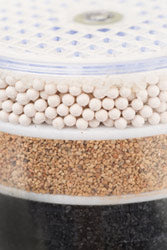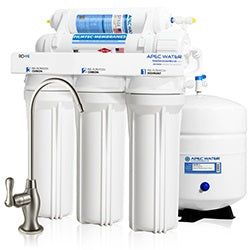Multi-media filters represent a significant improvement over single-media filters. This is due primarily to improved filter bed action based on the innovative use and selection of filter media. Multi-media filtration permits delivery of high quality filtered water at much faster flow rates, as compared to a conventional sand filter.
In a conventional sand filter, lighter and finer sand particles are found at the top of the filter bed, and coarser, heavier sand particles remain at the bottom after backwashing. Filtration takes place in the top few inches of the filter bed.
The multi-media filter is radically different. The multi-media filter bed, in comparison to the sand filter bed, is upside down. Coarse, but lighter, particles backwash to the top, whereas finer, but heavier, particles remain at the bottom of the bed. The innovation lies in the selection of suitable media. This configuration has many advantages. The entire bed acts as a filter, rather than only the top few inches. Turbidity is trapped throughout the bed, enabling the filter to hold far more solids filtered from the water before backwashing is necessary.
Multi-Media Filter Below

Typically, the filter bed is made up of three layers of filter media. The total bed depth is about 26 to 40 inches. In a three-layer filter, the top layer is made up of large, lighter-weight particles of anthracite coal and is from 15 to 18 inches in depth (particle size 1.0 to 1.5 millimeters, density 1.35 to 1.75). The middle layer contains from 8 to 15 inches of heavier and smaller particles of calcined aluminum silicate or sand (particle size 0.5 to 0.6 millimeters, density 2.65). The bottom layer contains from 3 to 6 inches of heavier garnet (particle size 0.2 to 0.3 millimeters, density 4.0 to 4.2). This semiprecious red silicate mineral is 50 to 60% heavier than sand.
A multi-media filter is backwashed in the same manner as a sand filter, using reverse or upward flow of water through the filter bed. The various layers of media retain their stratification because each material has a different density.
In a four-media filter a fourth or top layer contains from 3 to 6 inches of lighter and larger plastic pillows (particle size 2.0 to 4.0 millimeters, density 1.1 to 1.2). Their density is slightly above the density of water which is 1.0.
Advantages
- The multi-media filter can operate for much longer periods of time (five or more times as long at the same filtration rate) before backwashing is necessary because the bed can hold more turbidity. Turbidity is trapped and held throughout the entire bed depth, rather than the top one or two inches.
- Multi-media filtration is much better suited for use in a closed pressure tank since cracking of the bed, and subsequent breakthrough of turbidity is virtually eliminated and the need for visual inspection is unnecessary.
The use of pressure tanks, rather than open basins or filters, is an obvious advantage for point-of-use filtration and could also be of real importance in the filtration of small community water supplies.
More rapid filtration flow rates in multi-media filtration allow the use of smaller diameter tanks with equal or better results.
- A very high degree of clarity is achieved in the filtered water because of the fact that the finer particles of garnet at the bottom trap finer turbidity particles.
- Another important advantage is that the multi-media filter can clarify water at a much higher flow rate than a single-media sand filter (5.5 to 8 gallons per minute, as compared to 1.5 to 2.5 gallons per minute in a 12 inch diameter tank). This is 14 to 15 gpm per square foot of bed area, as compared to 2 gpm per square foot of bed area. This is a very important difference in the production of filtered water.
Central Systems
In small community water supply filtration the conventional massive sedimentation tank, which allows larger particles of turbidity to settle, is replaced by the centrifugal separator which does the same job in 1 % of the space.
Centrifugal separators have been used in mining and mineral recovery for many years. Solid particles entering the separation chamber are acted on by high centrifugal forces which move the particles to the outer separator walls and then down to a collection device at the bottom. At the same time, the clarified water moves toward the center of the separation chamber and upward to the clear water outlet at the top.
Separators can remove up to 98% of all suspended particles, down to particle size as small as three-thousandths of an inch (74 micrometers). A human hair has a thickness of about 100 micrometers.
In the multi-media filter the traditional feed of alum as a coagulant is reduced. At the same time, it is supplemented with a polymer (polyelectrolyte) which forms a stronger floc and is applicable over a broader turbidity range.
Contact Clarification
A separate tank, called a contact clarifier, provides hydraulic contact flocculation and surface storage clarification. This replaces traditional paddle flocculation and four hours of quiescent clarification. The sand filter which followed in the traditional system has been replaced by a more efficient multi-media filter. Thus, without process shortcuts, process time has been reduced from the traditional 41/2-6 hours to 8 minutes!
Typical results for multi-media systems include reduction from 200 NTU to 0.42 NTU on high turbidity water, and from 25 NTU to 0.15 NTU on low turbidity water.
According to recent news and reports, most tap and well water in the U.S. are not safe for drinking due to heavy industrial and environmental pollution. Toxic bacteria, chemicals, and heavy metals routinely penetrate and pollute our natural water sources making people sick while exposing them to long-term health consequences such as liver damage, cancer, and other serious conditions. We have reached the point where all sources of our drinking water, including municipal water systems, wells, lakes, rivers, and even glaciers, contain some level of contamination. Even some brands of bottled water have been found to contain high levels of contaminants in addition to plastic chemicals leaching from the bottle.
A good water filtration system installed in your home is the only way to proactively monitor and ensure the quality and safety of your drinking water. Reverse osmosis water purification systems can remove 90-99% of all contaminants from the city and well water to deliver healthy drinking water for you and your family.




